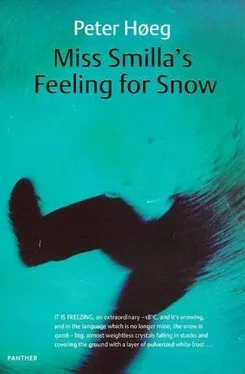Peter Høeg - Smilla's Sense of Snow aka Miss Smilla's Feeling for Snow
Здесь есть возможность читать онлайн «Peter Høeg - Smilla's Sense of Snow aka Miss Smilla's Feeling for Snow» весь текст электронной книги совершенно бесплатно (целиком полную версию без сокращений). В некоторых случаях можно слушать аудио, скачать через торрент в формате fb2 и присутствует краткое содержание. Жанр: Современная проза, на английском языке. Описание произведения, (предисловие) а так же отзывы посетителей доступны на портале библиотеки ЛибКат.
- Название:Smilla's Sense of Snow aka Miss Smilla's Feeling for Snow
- Автор:
- Жанр:
- Год:неизвестен
- ISBN:нет данных
- Рейтинг книги:3 / 5. Голосов: 1
-
Избранное:Добавить в избранное
- Отзывы:
-
Ваша оценка:
- 60
- 1
- 2
- 3
- 4
- 5
Smilla's Sense of Snow aka Miss Smilla's Feeling for Snow: краткое содержание, описание и аннотация
Предлагаем к чтению аннотацию, описание, краткое содержание или предисловие (зависит от того, что написал сам автор книги «Smilla's Sense of Snow aka Miss Smilla's Feeling for Snow»). Если вы не нашли необходимую информацию о книге — напишите в комментариях, мы постараемся отыскать её.
Smilla's Sense of Snow aka Miss Smilla's Feeling for Snow — читать онлайн бесплатно полную книгу (весь текст) целиком
Ниже представлен текст книги, разбитый по страницам. Система сохранения места последней прочитанной страницы, позволяет с удобством читать онлайн бесплатно книгу «Smilla's Sense of Snow aka Miss Smilla's Feeling for Snow», без необходимости каждый раз заново искать на чём Вы остановились. Поставьте закладку, и сможете в любой момент перейти на страницу, на которой закончили чтение.
Интервал:
Закладка:
One level up, a door opens onto the between decks. My flashlight finds distant walls, the high ridge where the cargo hold juts up, the bracing under the spot where the aft mast must stand. Clusters of white-painted electrical cables and the outlets of the sprinkler system.
The between decks is as wide as the ship, and is actually a single vast low-ceilinged room supported by columns; behind one end of the room are the coolers and storage rooms. The opposite end vanishes aft into the darkness.
That's the direction I head. After twenty-five yards there is a railing. Ten feet down my light strikes bottom. The aft cargo hold. I remember Jakkelsen's statistics: 1,000 cubic feet, as opposed to the 3,500 in the hold I've just looked at.
I take out my sketch and compare it with the space beneath me. It seems somewhat smaller than I've drawn it.
I go back to the spiral staircase and down to the first door.
Seen from the floor of the hold, it's understandable why it seems smaller than in my drawing. It's half filled with a rectangular shape five feet high under a blue tarp.
With my screwdriver I make two punctures and a rip in the canvas.
Keeping in mind the railroad ties, you might think we were on our way to Greenland to lay seventy-five yards of track and start up a rail company. Under the tarp there is a stack of rails.
But you wouldn't be able to attach them to the ties. They're welded together in a huge, rectangular construction with an iron bottom.
It reminds me of something. Then I let the thought pass. I'm thirty-seven years old. With age everything starts reminding you of something else.
Back on the between decks I glance at my alarm clock. By now the laundry room must be quiet. Someone might have called me. Someone might have come by.
I walk farther aft.
The vibrations in the hull tell me that the propeller must be somewhere below, right in front of my feet. According to my diagram, about fifteen yards away. Here the deck is cut off by a bulkhead with a door. Jakkelsen's key fits the lock. Inside, there is a red emergency light with a switch. I don't turn on the light. I must be on the floor beneath the low aft superstructure. It's been locked ever since I came aboard.
The hatch leads to a short passageway with three doors on either side. The key opens the first one on the right. No doors are closed to Peder Most and his friends.
Until not very long ago this room was one of three small cabins on the port side. Now the dividing walls have been torn down to create one room. A storeroom. Along the walls are rolls of blue 2-inch nylon hawsers. Woven polypropylene rope. Eight sets of quarter-inch Kermantel double rope in fluorescent alpine safety colors, an old friend from the ice cap. Every set costs 5,000 kroner, can handle up to five tons, and it's the only rope in the world that can stretch 25 percent of its own length.
Under straps there are aluminum ladders, firn anchors, tents, lightweight shovels, and sleeping bags. Metal hooks screwed into the walls hold ice axes, climbing hammers, pitons, carabiners, dynamic brakes, and ice screws-both the narrow ones that look like corkscrews and the wide ones: you screw a cylinder of ice into the core and they can hold an elephant.
Inside several metal cabinets along the wall, opened at random, I find wedges, glacier goggles, a crate of six Tommen altimeters. Frameless backpacks, Meindl boots, safety harnesses. Everything straight from the factory and wrapped in clear plastic.
The room to starboard was also formed by combining three cabins. There are more ladders and ropes and a fire chest marked EXPLOSIVES, which Jakkelsen's key unfortunately will not open. In three big cardboard boxes there are three identical examples of Danish quality craftsmanship: 20-inch manual winches with three gears from Sophus Berendsen, Inc. I don't know much about mechanical gear ratios, but they're as big as barrels and look as if they could lift a locomotive.
I pace off the hallway at eighteen feet. At the end a stairway leads up to deck level, where there's a toilet, a paint room, a metal shop, and a little mess hall used as a shelter when they're working on deck. I decide to postpone my inspection to another time.
Then I change my mind-.
I had left the door through which I came ajar. Maybe because the hallway and the small rooms would feel like a rat trap otherwise.
Maybe to see whether a light would be turned on behind me.
There's a sound now. Not much. Just a little noise that almost disappears in the sound of the propeller and the seething crash of the sea along the hull.
It's the sound of metal on metal. Cautious, but enhanced by the harsh echo of the room.
I head up the stairs to reach the deck. At the top there's a door. The key makes the latch click back, but the door doesn't open. It's battened down from the outside. I turn back.
In the darkness of the between decks, I withdraw to the side, squat down, and wait.
They arrive almost at once. There are at least two of them, maybe more. They move slowly, inspecting the space around them along the way. Discreet, but without making an effort to be quiet.
I put my flashlight on the deck. I wait for the Kronos to roll on a high swell. Then I turn on the flashlight and let it go. It starts rolling to starboard as its beam flickers across the pillars.
I run forward, along the side.
It doesn't distract them. In front of me is something that feels like a curtain. I try to push it aside, but it wraps around me. Then another flutters around my chest and face, and I scream, but the sound is muted by the heavy fabric and becomes merely a ringing in my own ears, along with the taste of dust and wool in my mouth. They've wrapped me up in fire blankets.
It was done deliberately, without violence or drama. They lay me down and put pressure on the blankets, and there is a new smell of mildew and jute. They've pulled a sack over the blankets, over my head-one of the sacks I saw so many of in the cargo hold.
They lift me up, still taking care; I'm lying across the shoulders of two men who carry me along the deck. Irrationally, the vain thought strikes me that I must look ridiculous.
A hatchway is opened and closed. On our way down the stairs they hold me stretched out between them. Blindness leads to an increased awareness in my body, but not once do I hit the stairs. If it hadn't been for the wrapping and the circumstances, they might have been carrying a patient on a stretcher.
A sound that is both muffled and close at hand tells me that we're outside the door to the engine room. The door is opened, we pass the engine room, and the sound dies out again. Time and distance seem longer. I feel as if we've been walking for an eternity before they take the first step upward. In reality, it can't have been more than eighty feet to the bottom step.
Now there's only one shoulder under me. I try to get my arms free.
I'm placed carefully on the floor; there's a slight vibration of metal somewhere above my head.
Now I know where we're going. The opened door doesn't lead anywhere; it opens onto the little platform where Jakkelsen and I stood, forty feet from the bottom. I don't know why, but I'm positive that they're going to throw me from that platform into the bottom of the tank.
I'm in a sitting position. A fold in the blankets allows me to pull my left arm up along my chest. I have the screwdriver in my hand.
When he lifts me up from the floor, my chest rests against his. I try to feel my way to where his ribs end, but I'm shaking too hard. Besides, the cork is still on the screwdriver.
He leans me against the railing and kneels in front of me, like a mother about to lift her child.
I'm sure that I'm going to die. But I push the thought aside. I refuse to accept this humiliation. There's a degrading coldness about the way they must have planned it. It was so easy for them, and now here I am: Smilla the Greenlander, about to go splat.
Читать дальшеИнтервал:
Закладка:
Похожие книги на «Smilla's Sense of Snow aka Miss Smilla's Feeling for Snow»
Представляем Вашему вниманию похожие книги на «Smilla's Sense of Snow aka Miss Smilla's Feeling for Snow» списком для выбора. Мы отобрали схожую по названию и смыслу литературу в надежде предоставить читателям больше вариантов отыскать новые, интересные, ещё непрочитанные произведения.
Обсуждение, отзывы о книге «Smilla's Sense of Snow aka Miss Smilla's Feeling for Snow» и просто собственные мнения читателей. Оставьте ваши комментарии, напишите, что Вы думаете о произведении, его смысле или главных героях. Укажите что конкретно понравилось, а что нет, и почему Вы так считаете.




![Рута Шепетис - Ashes in the Snow [aka Between Shades of Gray]](/books/414915/ruta-shepetis-ashes-in-the-snow-aka-between-shades-thumb.webp)







